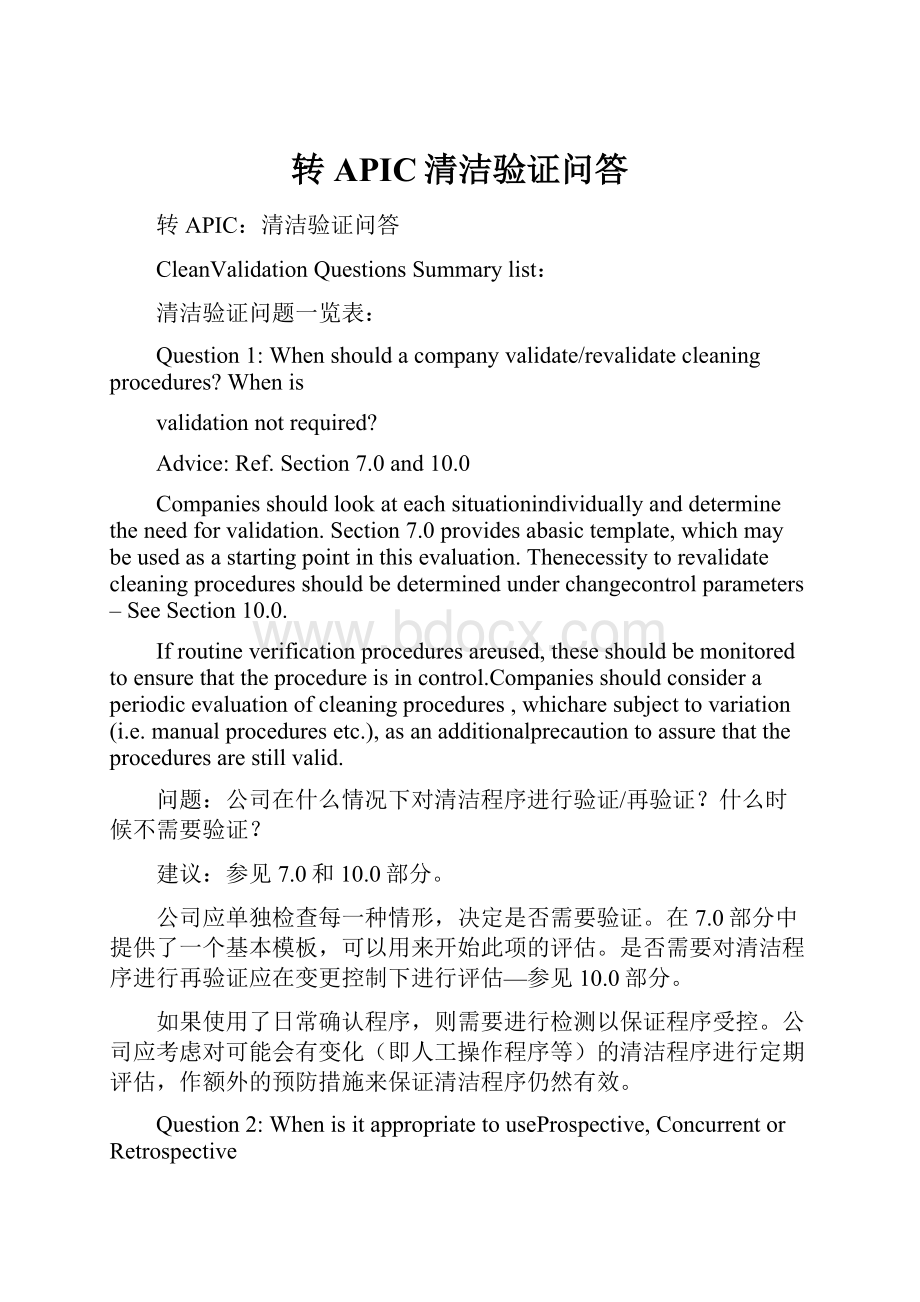转APIC清洁验证问答.docx
《转APIC清洁验证问答.docx》由会员分享,可在线阅读,更多相关《转APIC清洁验证问答.docx(10页珍藏版)》请在冰豆网上搜索。

转APIC清洁验证问答
转APIC:
清洁验证问答
CleanValidationQuestionsSummarylist:
清洁验证问题一览表:
Question1:
Whenshouldacompanyvalidate/revalidatecleaningprocedures?
Whenis
validationnotrequired?
Advice:
Ref.Section7.0and10.0
Companiesshouldlookateachsituationindividuallyanddeterminetheneedforvalidation.Section7.0providesabasictemplate,whichmaybeusedasastartingpointinthisevaluation.Thenecessitytorevalidatecleaningproceduresshouldbedeterminedunderchangecontrolparameters–SeeSection10.0.
Ifroutineverificationproceduresareused,theseshouldbemonitoredtoensurethattheprocedureisincontrol.Companiesshouldconsideraperiodicevaluationofcleaningprocedures,whicharesubjecttovariation(i.e.manualproceduresetc.),asanadditionalprecautiontoassurethattheproceduresarestillvalid.
问题:
公司在什么情况下对清洁程序进行验证/再验证?
什么时候不需要验证?
建议:
参见7.0和10.0部分。
公司应单独检查每一种情形,决定是否需要验证。
在7.0部分中提供了一个基本模板,可以用来开始此项的评估。
是否需要对清洁程序进行再验证应在变更控制下进行评估—参见10.0部分。
如果使用了日常确认程序,则需要进行检测以保证程序受控。
公司应考虑对可能会有变化(即人工操作程序等)的清洁程序进行定期评估,作额外的预防措施来保证清洁程序仍然有效。
Question2:
WhenisitappropriatetouseProspective,ConcurrentorRetrospective
ValidationAdvice:
Ref.Section9.0
RetrospectiveValidationofcleaningisnotcondonedbyregulatoryAuthoritiesProspectiveValidationistheidealmethodofvalidation.
Insituationswhereveryfewrunsaremanufacturedinanygivenperiodand/orabusinessdecisionhasbeentakentoreleasethenextmaterialmanufacturedaftercleaningbasedonahighleveloftestingoftheequipment(i.e.Validationlevel,)concurrentreleaseofmaterialmaytakeplace.
问题:
什么时候应该使用前验证、同步验证和回顾性验证?
建议:
参见9.0部分.
药监局不认可对清洁放啊进行回顾性验证。
前验证是理想的验证方法。
如果给定的时间段内只生产较少的轮次,且/或已从业务角度决定了清洁后的下一生产物料将在对设备较高水平测试(即:
验证水平)后才放行,则可以在验证同时放行物料。
Question3:
Whatleveloftestingisneededaftercleaningvalidation?
Advice:
Ref.Section5.3
Theanswertothisquestiondependsonindividualsituations.Typically,companiesperformvisualinspectionandtakerinsesamplestomonitortheeffectivenessofthecleaninginpre-definedintervals(timeornumberofbatches).
Ifaftervalidationcompanydecidestoperformalwayscleaningverificationnon-specificscientificallysoundanalyticalmethodsmaybeused.
Apracticalapproachformonitoringtheeffectivenessofcleaningaftercompletionofcleaningvalidationinaneffective,scientificsoundandinexpensivewayisgivenbelow:
1.)Visualinspectionofthecleanedequipment.Onlyafterthischeckisconsideredsatisfactory,proceedwiththenextstep.
2.)Takearinseand/orswabsample(onelitreofrinsingliquidisusuallyrequired)
3.)Determinethedryresiduebyevaporatingabout500mltodrynessinasmallflaskusingarotaryevaporator.Thisunspecifictestcoversalsoinorganicsalts,knownorunknownorganicproductsandwilldetectthetotalresidues.(thistestmightbeomittedforthedryingequipment,inthisinstancewehaveapureAPIorintermediateandtypicallynopotentialforsideproducts,degradation,etc.)
4.)Iftheresultmeetsthespecification,proceedtospecific(chromato-graphic)technique.StartwithaTLC-limittest(inexpensiveandfasttovalidate,broaddetectionrange–UVandspecificderivatisation–ifthesetechniquesarecombined,themethodisveryspecificforthedifferentimpuritiespotentiallypresentinthesample.Apply2samples:
thelastwashingliquid(toseeallpotentialresidues),therinsingliquid(tolookfortheresidue)andtwostandards:
oneofthesuspectedresidualproductataconcentrationthatisthelimitaccepted,anda1:
2dilutionofthestandard.Ifthemainspotintherinsingliquidhaslowerintensitythanthestandard,theequipmentisclean.Thesecondstandardisforconfirmationofdetection.
5.)IfTLCisnottheappropriatetechnique,reverttoHPLCorGC.
问题3:
清洁验证后的监测要求是怎么样的?
建议:
参见5.3部分。
对此问题的回答取决于各个不同情形。
一般来说,公司进行目视检查,然后以预定的间隔(时间或批次)取淋洗样品检查清洁的有效性。
如果公司决定在验证后一直实施清洁检查,可以采用非专属性且科学合理的方法。
以下给出了清洁验证完成后,较为实用的对清洁有效性进行监控的有效且科学合理的便宜方法:
1、 对清洁后的设备进行目视检查,此检查符合要求后,方可进入下一步。
2、 取一个淋洗样和/或擦拭样品(一般实用一升淋洗样)
3、 使用旋转蒸发器将约500ml样品在小烧瓶中蒸干检测蒸发残留。
该非专属方法包括了无机盐、已知或未知有机产品,可以检出总残留。
(烘干设备不需要做此项测试,此时,设备中只有纯的原料药或中间体,一般没有潜在的副产物、降解产物等)。
4、 如果结果符合标准,则可以采用特定的技术(色谱法).从TLC限度测试开始(便宜且易于验证,具有较宽的检测范围—紫外和特定衍生产品—如果将这些技术合并,方法会可能出现在样品中的不同杂质具有专属性),测试2个样品,一个是最后洗涤液(检查所有潜在残留物),一个是淋洗液(检查实际残留),测试两个标准品,一个是认为可能残留的产品,浓度为可接受的限度,另一个是1:
2稀释的标准品。
如果淋洗液中的主斑点不深于标准,则认为设备已经清洁。
第二个标准品是用来确认检测限的。
5、 如果TLC不适用,改用HPLC或GC。
Question4:
Whatcriticalparametersneedtobelookedatduringcleaningvalidation?
Advice:
Ref.Section8.2fordetails
Itisvitalthattheequipmentdesignisevaluatedindetailinconjunctionwiththeproductresiduestoberemoved,theavailablecleaningagentsandthecleaningtechniques.Alsotheruggednessandreproducibilityofthecleaningprocedureshouldbecovered.
问题4:
在清洁验证过程中,要查看哪些关键的参数:
建议:
参见8.2部分。
在设备设计中,要结合需要清除的产品残留、可以获得的清洁剂和清洁技术进行评估。
还要包括清洁程序的耐用性和可重复性。
Question5:
Whatnumberofcleansshouldberuninordertovalidateacleaning
procedure?
Advice:
Ref.Section9.0
Avalidationprogramgenerallyencompassesthreeconsecutivesuccessfulreplicates.However,companiesshouldevaluateeachsituationindividually.
问题5:
要验证一个清洁程序,需要重复几轮清洁?
建议:
参见9.0部分。
一个验证程序一般是经过三次连续成功的重复。
但是,公司应对各种情形进行单独评估。
Question6:
Isitacceptableforavalidatedcleaningproceduretobecontinueduntiltheanalyticalresultsdemonstrateitisclean?
Advice:
Regulatoryauthoritiesdonotcondonethispractice.
Whentheanalyticalresultdoesnotmeettheacceptancecriteriaaninvestigationtodeterminethepossiblerootcauseshouldbeperformed.Ifneededre-trainingoftheoperatorsshouldbeperformedand/oradjustmentofthecleaningproceduretosolvetheissue.
问题6:
是否可以重复一个ing过验证的清洁操作直至分析结果显示其已清洁?
建议:
药监当局不接受这种方法。
如果检测结果不符合可接受标准,则需要进行调查,找出可能的根本原因。
必要时,应对操作人员进行再次培训,和/或对程序进行调整以解决问题。
Question7:
Isitnecessaryforcompaniestovalidateamaximumtimeallowedfora
pieceofequipmenttobedirtybeforecleaning?
Advice:
CompaniesshouldhaveSOPsinplace,whichrequirecleaningtobeperformed
immediatelyafterproductionhasstopped.Thisscenarioshouldbevalidated.
However,ifforsomereasonimmediatecleaningisnotalwayspossible,companiesshouldconsidertheeffectoftimeonthematerialdepositedontheequipment.Itmaybepossibleto‘Group’or‘Bracket’products,andvalidateaworstcasescenario.
问题8:
公司是否需要验证在清洁前,脏的设备可以放置的最长时间。
建议7:
公司应制订SOP,其中说明生产结束后应立即对设备进行清洁,这种情况是需要验证的。
但是如果因为某些原因,使得设法总是立即清洁,公司应考虑放置时间对设备中残留物料的影响。
可以考虑对于“一组”或“一类”产品,验证其最差情形。
Question8:
Isitnecessaryforcompaniestovalidateamaximumtimeallowedfora
pieceofequipmenttobeleftcleanbeforere-use?
Advice:
CompaniesshouldhaveSOPsinplacetoensurethatpiecesofequipmentareadequatelyprotectedfromanycontaminationaftercleaninghastakenplacei.e.ensurethattheequipmentisadequatelycovered,closedfromdustetc.
Ifthecompanyfeelsthatthereisanyriskofcontaminationduring‘idletime’aftercleaning,validationshouldbeconsidered.
问题8:
公司是否需要验证在清洁后,已清洁的设备再使用前可以放置的最长时间?
建议:
公司应制订SOP,保证清洁后的设备受到充分的保护,不受到污染,例如保证设备被遮盖、关闭防止灰尘进入等。
如果公司觉得在清洁后的“闲置时间”内还是被污染的风险,则需要考虑验证。
Question9:
Isitnecessarytoestablishtimelimitsforcleaningifequipmentisnotused
frequently?
Advice:
Pleaseseepreviousadvicetoquestion8.
问题9:
对于不经常使用的设备,是否需要设定清洁时间限制?
建议:
参见问8的回答:
Question10:
Whatisthemaximumtimeallowedaftercleaningwithwateraslastrinse?
Advice:
Equipmentshouldnotbeleftwithwaterinitaftercleaning.Thelaststepofthe
cleaningprocedureinvolvedryingwithsolventorflushingwithNitrogen,thus
ensuringthatthereisnoopportunityformicrobialgrowth.
问题9:
对于不经常使用的设备,是否需要设定清洁时间限制.
建议:
请参见问8的回答。
Question11:
Isitpossiblethatadeteriorationofequipmentmaytakeplaceovertime,thus
invalidatingtheoriginalvalidationresults?
Advice:
Materialsusedtomanufactureequipmentforthepharmaceutical/chemicalindustryisofaveryhighstandard.However,equipmentmaterialsusedshouldbeevaluatedtoensuretheirdurabilityovertimeaspartofthepreventativemaintenanceprogramme.Thepossibilityofsurfaceroughnessandanypossibleeffectsthatitmayhaveoncleaningshouldbeconsidered.
Companiesemployingverificationmethodsaftervalidationshouldmonitoranalyticaldatageneratedaspartofthisprocess.
问题11:
是否有可能经过一段时间,设备情况会变差,这样原来的验证结果不再有效?
用于药品/化学行业生产的设备的材质一般都有很高的标准,但是,所用的设备材质应经过评估,保证其能经受一段时间的使用,这应该是预防性维护保养计划的一部分,要考虑表面粗糙的可能性,以及可能对清洁产生的影响。
Question12:
Ifacompanyhasvalidatedaworstcasescenario(groupingorbracketing
regime),shouldtheyalsoneedtovalidatea‘less’worstcase?
Advice:
Whengroupingproductsanddeterminingworstcasesituationscenarioforvalidation,companiesshoulddeterminewhetherornottheworstcasebeingvalidatedisone,whichisappropriateforroutinemanufacture.Foroperationalreasonsitmaybebeneficialtovalidatea”less”stringentcleaningprocedureforsomeproducts.
问题12:
如果一个公司已经验证了最差情形(分组或分类),是否还需要验证“较差”情形?
如果将产品分组,并确定了最差情形用于验证,公司应决定所验证的最差的情形适用于日常生产。
由于操作原因,可能需要对某些产品的“其次”严格的清洁程序进行验证。
Question13:
Inacaseofadedicatedplantwithnodegradants,isthereaneedtovalidate?
Advice:
Ref.Section7.0
Companiesshouldconsidereachsituationindividuallyandvalidatewherethereisapotentialforcontamination.Intheabovesituation,theremaynotbeaneed.However,considerationshouldbegiventothenumberofrunsbeingperformedpriortofullcleaning.
问题13:
如果使用的是专用车间,且没有降解产物,是否还需要进行验证呢?
建议;参见7.0部分。
公司要单独考虑每种情形,如果有潜在污染时则需要验证。
在上述情形下,可能不需要验证。
但是,要考虑在进行全面清洁前可以生产的轮次。
Question14:
Shouldcleaningvalidationbepartofadevelopmentprogramme?
Advice:
WhileitisnotarequirementofICHthatcleaningvalidationbeperformedduring
developmentphasethefollowingshouldbeconsidered:
Iftheequipmentbeingcleanedafterthedevelopmentproductinquestionisusedtomanufacturecommercialproductorproductforhumanuseforexampleclinicaltrials,itisessentia